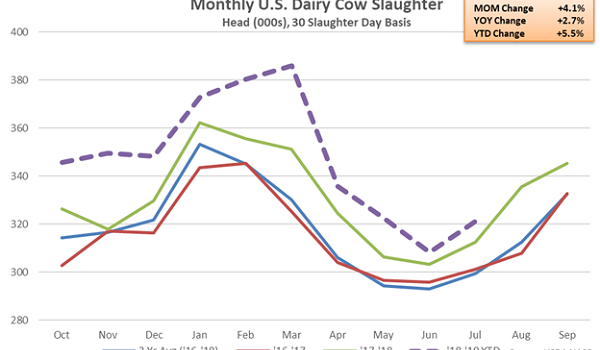
U.S. Dairy Cow Slaughter Update – Aug ’19
Executive Summary
U.S. dairy cow slaughter figures provided by USDA were recently updated with values spanning through Jul ’19. Highlights from the updated report include:
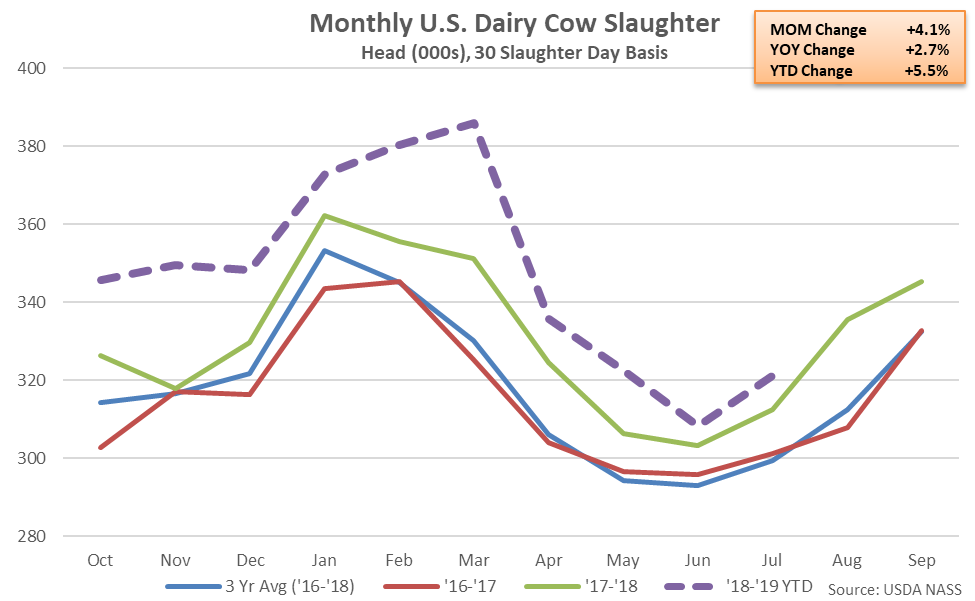 ’17-’18 annual dairy cow slaughter rates increased 4.8% YOY, reaching a five year high level, while ’18-’19 YTD dairy cow slaughter rates have increased an additional 5.5% on a YOY basis throughout the first ten months of the production season. ’18-’19 YTD dairy cow slaughter rates are on pace to reach a 33 year high level through Jul ’19.
’17-’18 annual dairy cow slaughter rates increased 4.8% YOY, reaching a five year high level, while ’18-’19 YTD dairy cow slaughter rates have increased an additional 5.5% on a YOY basis throughout the first ten months of the production season. ’18-’19 YTD dairy cow slaughter rates are on pace to reach a 33 year high level through Jul ’19.
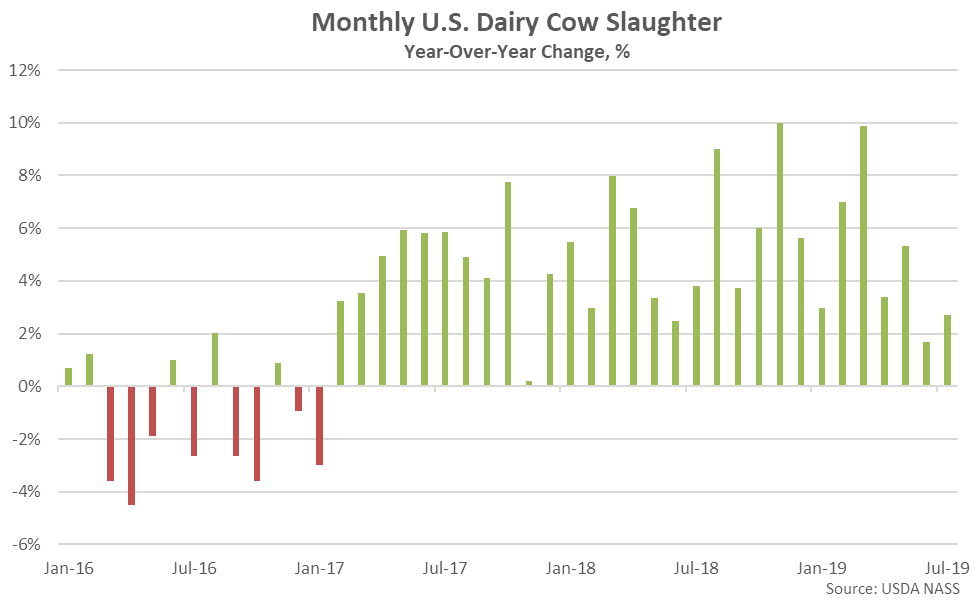 Recent increases in slaughter rates have contributed to the U.S. milk cow herd declining from the 23 year high levels experienced during the early months of 2018. The Jul ’19 U.S. milk cow herd declined 9,000 head from the previous month’s revised figure, reaching a three and a half year low level. The U.S. milk cow herd currently stands at 9.310 million head, finishing 82,000 head below previous year figures and 128,000 head below the 23 year high level experienced during Jan ’18.
Recent increases in slaughter rates have contributed to the U.S. milk cow herd declining from the 23 year high levels experienced during the early months of 2018. The Jul ’19 U.S. milk cow herd declined 9,000 head from the previous month’s revised figure, reaching a three and a half year low level. The U.S. milk cow herd currently stands at 9.310 million head, finishing 82,000 head below previous year figures and 128,000 head below the 23 year high level experienced during Jan ’18.
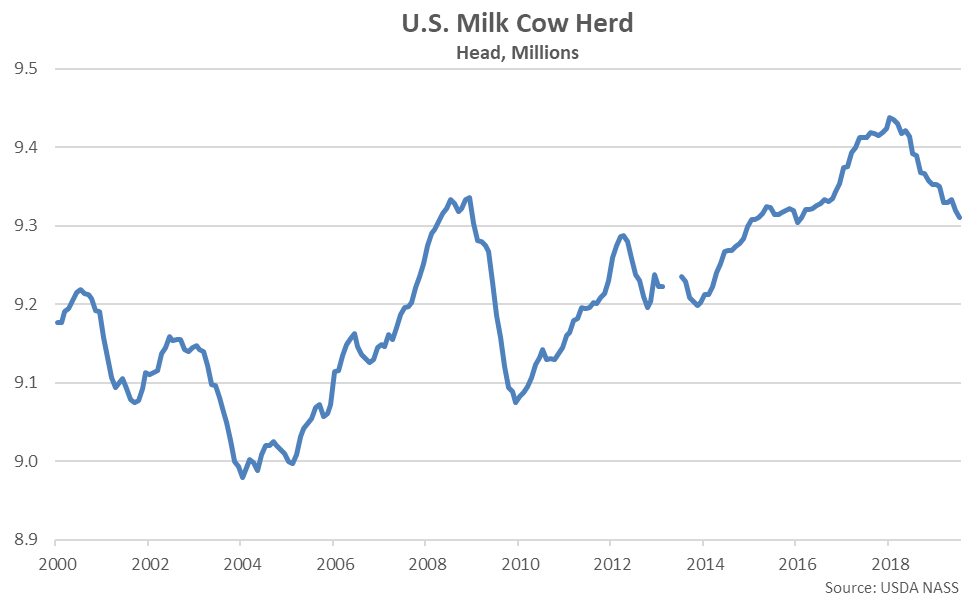 The most significant Jul ’19 MOM increase in dairy cow slaughter was experienced within Standard Federal Region 9 (Arizona, California, Hawaii and Nevada), followed by Standard Federal Region 5 (Illinois, Indiana, Michigan, Minnesota, Ohio and Wisconsin).
The most significant Jul ’19 MOM increase in dairy cow slaughter was experienced within Standard Federal Region 9 (Arizona, California, Hawaii and Nevada), followed by Standard Federal Region 5 (Illinois, Indiana, Michigan, Minnesota, Ohio and Wisconsin).
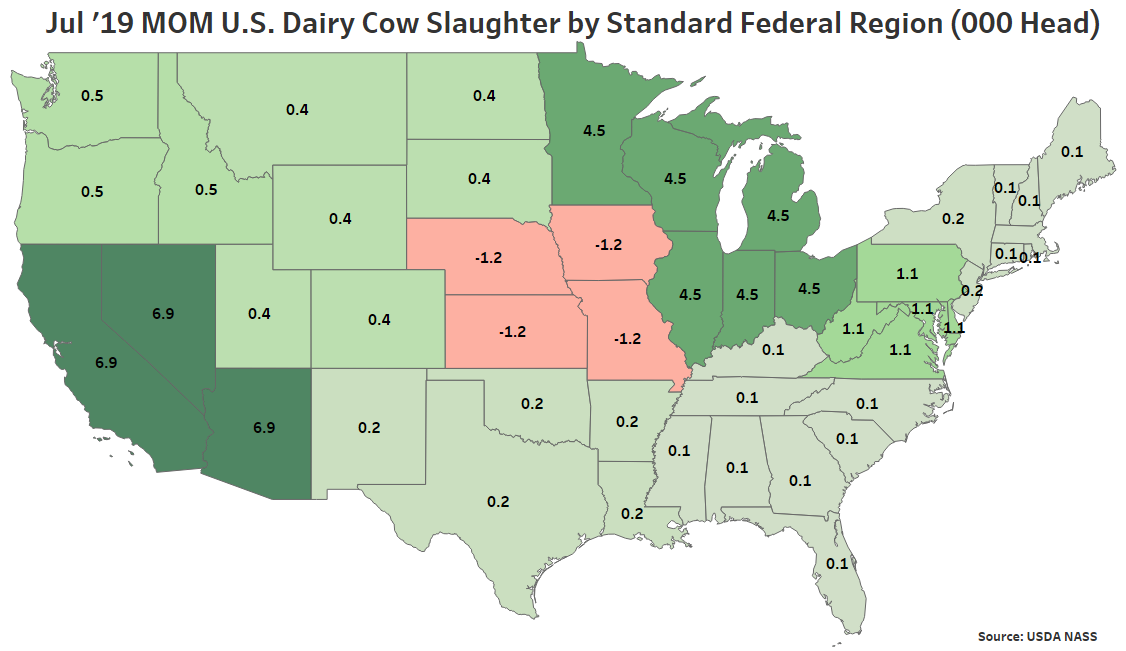 YOY increases in Jul ’19 dairy cow slaughter rates were led by Standard Federal Region 6 (Arkansas, Louisiana, New Mexico, Oklahoma and Texas), followed by Standard Federal Region 4 (Alabama, Florida, Georgia, Kentucky, Mississippi, North Carolina, South Carolina and Tennessee), while dairy cow slaughter rates declined most significantly on a YOY basis throughout Standard Federal Region 9 (Arizona, California, Hawaii and Nevada).
YOY increases in Jul ’19 dairy cow slaughter rates were led by Standard Federal Region 6 (Arkansas, Louisiana, New Mexico, Oklahoma and Texas), followed by Standard Federal Region 4 (Alabama, Florida, Georgia, Kentucky, Mississippi, North Carolina, South Carolina and Tennessee), while dairy cow slaughter rates declined most significantly on a YOY basis throughout Standard Federal Region 9 (Arizona, California, Hawaii and Nevada).
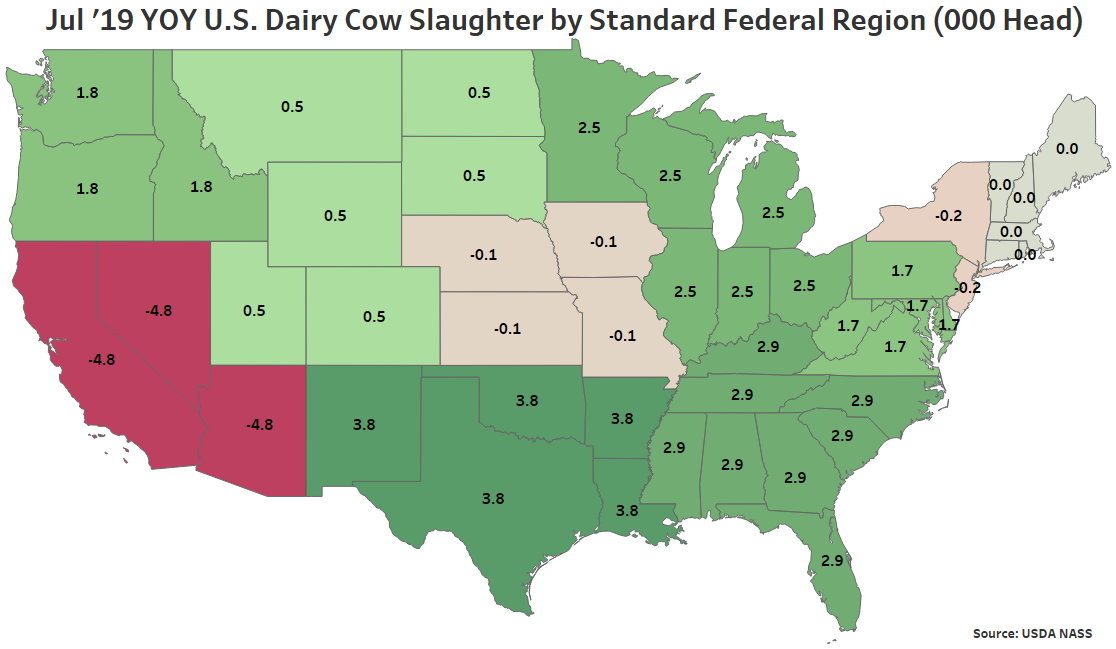
- U.S. dairy cow slaughter rates rebounded seasonally while remaining higher on a YOY basis for the 30th consecutive month during Jul ’19, finishing up 2.7% when normalizing for slaughter days. Dairy cow slaughter rates reached a 33 year seasonal high level for the month of July.
- Jul ’19 MOM increases in dairy cow slaughter were led by Standard Federal Region 9 (Arizona, California, Hawaii and Nevada).
- Jul ’19 YOY increases in dairy cow slaughter were led by Standard Federal Region 6 (Arkansas, Louisiana, New Mexico, Oklahoma and Texas), while YOY declines in dairy cow slaughter rates were most significant throughout Standard Federal Region 9 (Arizona, California, Hawaii and Nevada).
 ’17-’18 annual dairy cow slaughter rates increased 4.8% YOY, reaching a five year high level, while ’18-’19 YTD dairy cow slaughter rates have increased an additional 5.5% on a YOY basis throughout the first ten months of the production season. ’18-’19 YTD dairy cow slaughter rates are on pace to reach a 33 year high level through Jul ’19.
’17-’18 annual dairy cow slaughter rates increased 4.8% YOY, reaching a five year high level, while ’18-’19 YTD dairy cow slaughter rates have increased an additional 5.5% on a YOY basis throughout the first ten months of the production season. ’18-’19 YTD dairy cow slaughter rates are on pace to reach a 33 year high level through Jul ’19.
 Recent increases in slaughter rates have contributed to the U.S. milk cow herd declining from the 23 year high levels experienced during the early months of 2018. The Jul ’19 U.S. milk cow herd declined 9,000 head from the previous month’s revised figure, reaching a three and a half year low level. The U.S. milk cow herd currently stands at 9.310 million head, finishing 82,000 head below previous year figures and 128,000 head below the 23 year high level experienced during Jan ’18.
Recent increases in slaughter rates have contributed to the U.S. milk cow herd declining from the 23 year high levels experienced during the early months of 2018. The Jul ’19 U.S. milk cow herd declined 9,000 head from the previous month’s revised figure, reaching a three and a half year low level. The U.S. milk cow herd currently stands at 9.310 million head, finishing 82,000 head below previous year figures and 128,000 head below the 23 year high level experienced during Jan ’18.
 The most significant Jul ’19 MOM increase in dairy cow slaughter was experienced within Standard Federal Region 9 (Arizona, California, Hawaii and Nevada), followed by Standard Federal Region 5 (Illinois, Indiana, Michigan, Minnesota, Ohio and Wisconsin).
The most significant Jul ’19 MOM increase in dairy cow slaughter was experienced within Standard Federal Region 9 (Arizona, California, Hawaii and Nevada), followed by Standard Federal Region 5 (Illinois, Indiana, Michigan, Minnesota, Ohio and Wisconsin).
 YOY increases in Jul ’19 dairy cow slaughter rates were led by Standard Federal Region 6 (Arkansas, Louisiana, New Mexico, Oklahoma and Texas), followed by Standard Federal Region 4 (Alabama, Florida, Georgia, Kentucky, Mississippi, North Carolina, South Carolina and Tennessee), while dairy cow slaughter rates declined most significantly on a YOY basis throughout Standard Federal Region 9 (Arizona, California, Hawaii and Nevada).
YOY increases in Jul ’19 dairy cow slaughter rates were led by Standard Federal Region 6 (Arkansas, Louisiana, New Mexico, Oklahoma and Texas), followed by Standard Federal Region 4 (Alabama, Florida, Georgia, Kentucky, Mississippi, North Carolina, South Carolina and Tennessee), while dairy cow slaughter rates declined most significantly on a YOY basis throughout Standard Federal Region 9 (Arizona, California, Hawaii and Nevada).
